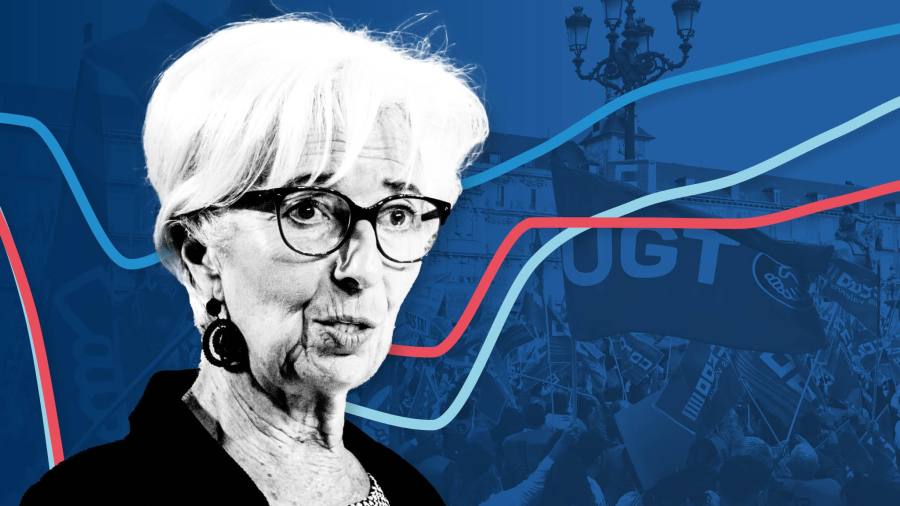
Receive free EU employment updates
We’ll send you a myFT Daily Digest email rounding up the latest EU employment news every morning.
Eurozone rate-setters are becoming increasingly concerned about an apparent disconnect between a seemingly buoyant jobs market and mounting signs of economic stagnation.
Unemployment in the region is at a record low and companies are struggling to fill vacancies. But the eurozone economy has suffered a mild contraction over the past two quarters.
The disconnect between the strength of the jobs market and the weakness of growth lies in a fall in workers’ productivity, which is contributing to a 5.5 per cent inflation rate that remains far too high for rate-setters’ liking.
The European Central Bank’s hawks are intent on avoiding the fate of the UK, where the tight labour market is exacerbating even higher inflation than in the eurozone. They want more increases in borrowing costs, despite already raising their benchmark deposit rate by 4 percentage points to 3.5 per cent.
Christine Lagarde, ECB president, has warned that unless companies are willing to “absorb” the cost of the drop in productivity, monetary policy will have to become even more restrictive.
But some economists believe more rate rises could kill jobs without having much impact on prices. So what conclusions on the labour market should the ECB draw ahead of its next monetary policy meeting later this month?
People are working fewer hours
On the face of it, the eurozone’s jobs recovery has been almost as impressive as in the US.
Figures published last week showed eurozone unemployment stayed at a historic low of 6.5 per cent in May, even as the economy flatlined. Business surveys suggest labour shortages are still widespread and companies keen to hire, even if the vacancy rate has come down slightly from a post-pandemic high.
However, although there are more jobs, and a higher proportion are full-time, people are working fewer hours on average.
This could reflect a growing preference for leisure time after the dislocation of the Covid pandemic led people to rethink their priorities. Peter Schaffrik of RBC Capital Markets said shorter working hours reflected “durable behavioural changes . . . that are unlikely to be reversed”.
The ECB suspects it has more to do with labour hoarding, where companies hang on to workers even as business tails off because they are worried they will be unable to hire again easily when the economy picks up.
Either way, companies will have to take on more staff just to keep output constant. This could in turn mean interest rates need to rise and stay high for longer, to keep wage pressures in check.
Most of the jobs growth is in less productive sectors
The ECB has drawn attention to another factor that could explain the disconnect between employment and growth: a lot of the job creation has been in the public sector, where working hours tend to be shorter, and in services, where productivity tends to be lower than in industry.
This is especially so in Germany and Spain, where a surge in hiring in health and education has offset sluggish private sector demand.
If there is a permanent shift to public from private sector jobs, then that would imply productivity would be lower in the longer run.
Some economists share the view that the weaker trend in productivity will endure.
Alexandre Stott, an economist at Goldman Sachs, said the recent fall will be “at least somewhat permanent in nature and only slowly reflected in wage agreements”.
The recovery may be more fragile than it looks
Other economists have argued that, if it raises rates too high, the ECB risks needlessly destroying jobs that the bloc’s poorer economies desperately need. In many southern European job markets employment has still not fully recovered from the 2008 financial crisis.
Nicolas Goetzmann, head of research at the Paris-based asset manager Financière de la Cité, said record high employment gave an illusion of strength, but masked huge variation between the bloc’s big economies.
Outside the public sector, employment in Germany had fallen, he said. Private sector jobs growth was being driven by France, largely owing to a surge in apprenticeships backed by government subsidies.
“There is no fairytale concerning the euro area and employment,” said Goetzmann, adding that companies hoarding labour could swiftly turn to job cuts if the economic situation worsened. “It is frightening now that the ECB is fighting so hard against domestic demand . . . to break a labour market that for the first time in 40 years is starting to be a bit better.”
Erik Nielsen, chief economics adviser at UniCredit bank, said the ECB’s own projections showed wages would barely keep pace with prices if measured from the onset of the inflation shock. “We are still way underwater,” he said. Since pay gains had mainly been in northern Europe, he added, there had also been a much-needed rebalancing within the eurozone, which would help southern Europe compete.
The wrong indicator?
Others say that, even if the ECB’s intuition on productivity and inflation is correct, the central bank is watching the wrong indicator.
The ECB is focusing on unit labour costs, with Lagarde pointing to a rise in this measure as evidence that productivity had weakened in the face of wage pressures.
This rise in unit labour costs was, the ECB president said, “a key reason why we recently revised up our projections for core inflation”.
But economists such as Claus Vistesen of consultancy Pantheon Macroeconomics say the measure is “hugely lagging”. Unit labour costs are, he said, “the last thing to turn just before recession hits”.
“If you set policy relative to unit labour costs . . . there’s a 90 per cent chance you’re going to get it wrong.”